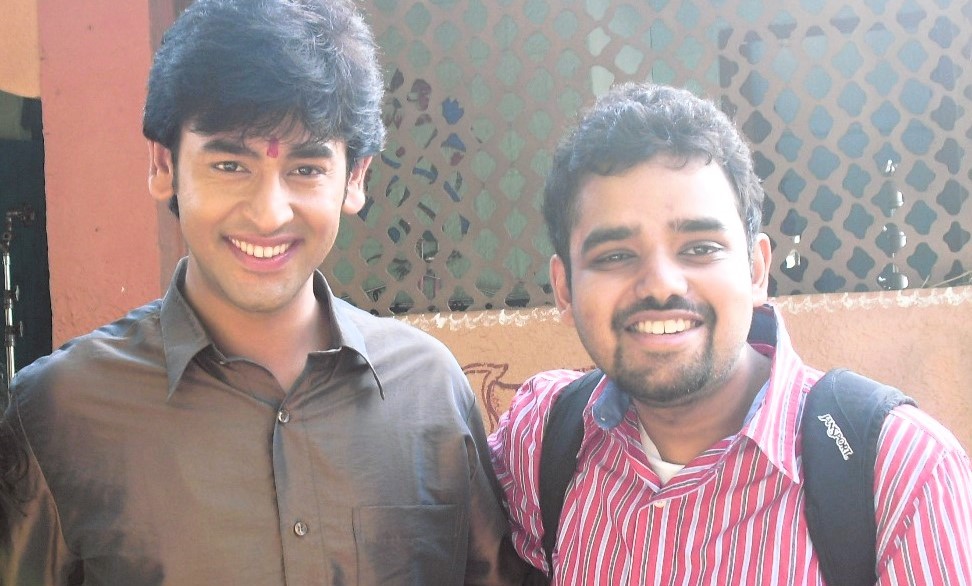Tales from the Shooting Floors of Balika Vadhu!
It’s serendipitous that my foray into Hindi television started with a show set in the land of my ancestors – Rajasthan. My journey as a writer on Balika Vadhu began with a meeting with Rajesh (Dubey) ji at the Sphere Origins office in Andheri; incidentally, my first visit to a production company’s office. Their headquarter was a stone’s throw away from Balaji Telefilms and Yash Raj films – two production houses I had grown up admiring.
My first visit to the Balika Vadhu set left a lasting impression.

The studio, situated in Naigaon, a suburb at the north tip of Bombay, was nearly a two-hour journey from the city. I often wondered how the cast and crew had time for anything else with the long travel times for their 12-hour shooting shifts. Naigaon, offering cheaper rentals and a fresher landscape for outdoor scenes, had been chosen due to the high demand and overpriced studios in the city. Though it now hosts several studios, Sphere Origins was the first to construct their set, which was then, and still is to a degree, surrounded by green pastures and cowsheds.
Shooting remotely comes with its own challenges. Public transportation was virtually nonexistent, as were streetlamps for night driving. As a junior crew member, I hesitated to request the use of a production vehicle. For my many visits, I’d opt for the local train to the Naigaon station, followed by an overpriced, non-negotiable auto-rickshaw ride. While the journey there was straightforward, getting an auto back to the station was tricky. It was tough to locate one passing on the Mumbai-Ahmedabad highway that ran parallel to the studio. At times I’d wait for up to an hour, thumb out, hoping someone would give a lift. Its hilarious now to remember once paying 300 Rupees to share an auto-rickshaw with four fisherwomen and their baskets; the only time I’ve squeezed into the front seat with the auto-driver, both of us holding on for dear life.
Most TV show sets are typically housed within large, enclosed studio floors – mundane warehouse-looking buildings that are transformed into the interiors of royal havelis and sleek bungalows. The studio floor becomes the primary shooting spot for a show, remaining its premises throughout the show’s run.
The Balika Vadhu set, fictionally known as Kalyani Devi’s haveli, stood for eight years, only to be dismantled and replaced in 2016 by the home of another fictional family. Ironically, I later discovered the floor was used for another soap of mine – Devanshi on Colors; Unfortunately, Devanshi shut down before I could verify this in-person.
Apart from the haveli shooting floor, I believe two floors were used as warehouses to stock props and costumes. Next to the rows of shooting floors, the studio had the standards of typical filming locations: a hospital, temple, courtroom, prison, marketplace, and a few single-story houses of smaller scale. Unlike our grand haveli built on a soundstage, most of these tertiary locations were permanent structures due to their usability in shows of all formats and genres. One, in particular, that remains vivid in my memory is a Kutch-haveli used in Star Plus’ Gulaal. I wonder if this bungalow found utility amongst subsequent serials, or if was demolished for a newer structure.
When scenes were penned to take place outside of the ‘haveli’, our production crew of 100-odd folks transformed these other studio areas to represent dusty village of Jaitsar. I recall taking my family for a studio tour during one of their Bombay visits. Owing to no shoot scheduled at the haveli set, we spent much of the day at ‘Gauri’s parents’ home’, one of the single-story houses mentioned in the previous paragraph.
To this day, my mother recounts this memory with a childlike fascination. The show was at a major turning point: Jagya, an already-married man, had just eloped with Gauri; and the couple was now taking blessings from her parents. Director Pradeep Yadav was calling action, instructing Shashank Vyas to ‘poora jhuko’ while getting aashirwad. To Gauri’s parents, his guidance was – “feelings laao, feelings. Beti ki shaadi ho rahi hai. Lagna chaahiye!”
I introduced the actors to my family once the take was over. After the handshakes and hugging, Shashank recounted going to Siddhi Vinayak temple the previous week, where a woman, blurring the lines between fiction and reality, taunted him – “mandir aane ka kya faayda, vaise hi itne paap kar rahe ho!” Anjum who had to sit on a white monobloc chair, chatted with us as one makeup person painted her nails red and another layered her eye shadow.
As a bonus, my family also caught some behind-the-scenes action of Zee TV’s Bhagonwali, the crew of which was shooting in the ‘hospital’ close by.
I can, of course, never forget my most memorable set visit yet – the day Balika Vadhu shot at a movie theater. As part of the plot, the women of the house, decked in their ghunghats and ghagras, go to the cinema to watch a screening of Dabangg. The sequence had been written, If I remember correctly, to promote the film’s upcoming TV premiere on Colors. The shoot will also always remain special as it marks the first time I met Surekha Sikri and Pratyusha Banerjee. Both women were beautiful actors, and may they rest in peace.
For the Dabangg scene, the producers went all out, securing one of the last standing single-screen theaters (the name of which I cannot recall) to recreate Jaitsar’s cinema. It was a pricier, unconventional shoot that required numerous junior artists to fill the seats around the actors. Clearly, the cost seemed justified as the footage would span the duration of two episodes.
I had learned the basics of cost justification just a few weeks prior when I penned a scene featuring Jagya and Gauri on a movie theater date. I was soon informed by the creative team that we couldn’t justify reserving an entire theater for a mere five-minute scene. The scene was then rewritten, with Jagya and Gauri now chatting on the road ‘outside’ the theater, ‘after’ they had watched their movie!
Stepping back to the Dabangg sequence, my favorite part remains Dadisa’s unexpected joyous reaction to eating popcorn (or makai ke phule as she calls them) for the first time. As a follow-up, I remember adding a bit to the episode that followed – with Dadisa instructing her beendanis to make popcorn for breakfast!
Also memorable of course, is Dadisa’s horrified reaction to Munni Badnam Huyi. Upon returning home, she
refers to her as “Ek chorri thi, Munni!” adding further that she is bound to be badnaam of she wears such clothes and dances. The following week, I walked by the editing suite where this very scene was being knitted together. In the middle of his chuckle, one editor asked the other – “Yeh comedy episode hai kya?” (Is this a comedy episode?)
As the saying goes, your first impression is often the last impression. The universe decided to become generous one day, and I somehow became a part of it. This is the only way I can explain how a legendary show like Balika Vadhu became my first impression of show business. There is so much to say, so many more memories to relive.
Feel free to drop your thoughts or share your favorite moments from Balika Vadhu in the comments below. Your connection means the world to me. Until the next installment, keep the Bollywood magic alive in your hearts!





